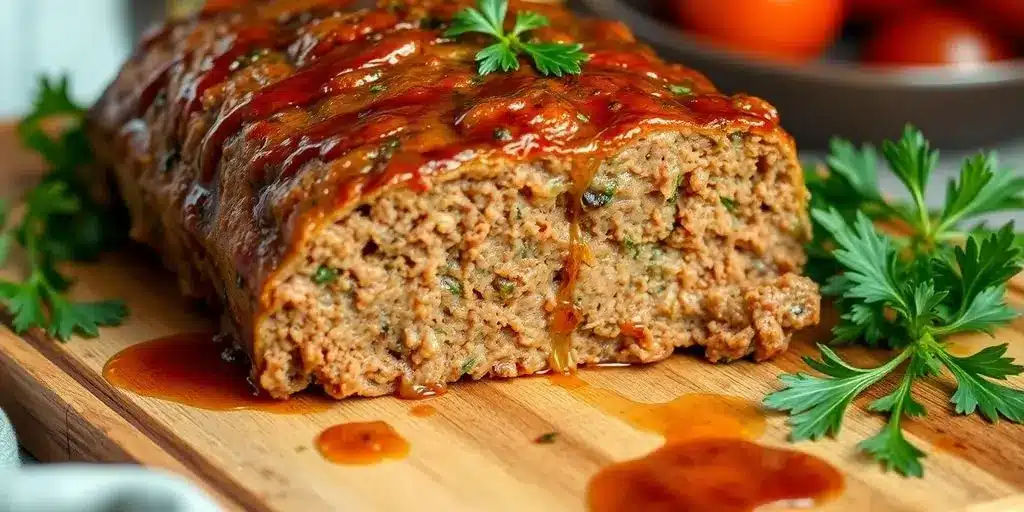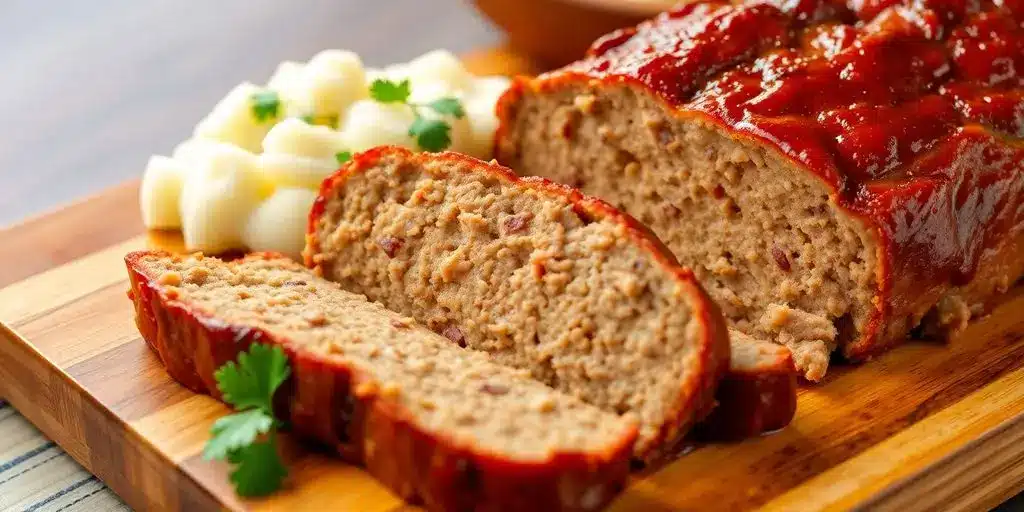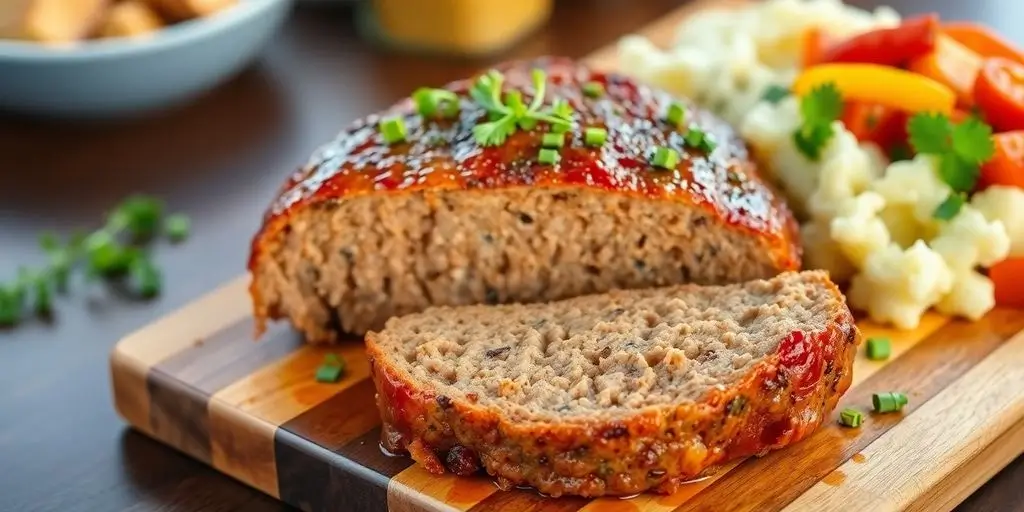Ever bit into a meatloaf that felt like chewing on a brick? Yeah, that’s not fun. However, making meatloaf that’s moist meatloaf and tasty isn’t rocket science. There are, in fact, a few tricks to get it just right. Whether you’re a seasoned cook or just starting out, these tips will make sure your meatloaf turns out juicy and delicious every single time.
Table of contents
Key Takeaways
- First, use eggs to bind the ingredients together, keeping it moist.
- Next, incorporate milk to help retain moisture and add a creamy texture.
- Additionally, mix in flavor boosters like ketchup and Worcestershire sauce for depth.
- Furthermore, avoid overmixing to keep the texture light and not dense.
- Finally, use a meat thermometer to ensure it’s cooked just right without drying out.
Essential Ingredients for Juicy Meatloaf
Eggs: The Binding Agent
Eggs are more than just a binding agent in your meatloaf. They bring a richness that helps to keep the loaf together while adding moisture. Without eggs, your meatloaf might fall apart, and you’ll miss out on that tender, cohesive texture. When combined with breadcrumbs, eggs help lock in the juices, making sure every slice is as juicy as the last.
Milk: A Moisture Retention Hero
Milk might seem like an odd addition to meatloaf, but it’s a game-changer. It soaks into the breadcrumbs, creating a moist texture that carries through the entire loaf. This trick is crucial for a meatloaf moist enough to savor every bite. Using whole or 2% milk works best, though you can opt for a non-dairy substitute if needed.
Flavor Enhancers: Ketchup and Worcestershire Sauce
Adding ketchup and Worcestershire sauce to your meatloaf mix isn’t just about flavor. These ingredients infuse the meat with a sweet and tangy taste while helping to retain moisture. A good meatloaf isn’t just about the beef; it’s about the balance of flavors that complement the savory taste of the meat. Season your meatloaf with a generous amount of salt and black pepper to enhance these flavors even further.
Don’t forget the pepper and garlic! These ingredients add depth and complexity, transforming a simple loaf into a mouthwatering dish.
Here’s a quick list of essentials to keep your meatloaf juicy:
- Use eggs to bind and add richness.
- Incorporate milk for moisture retention.
- Flavor with ketchup and Worcestershire sauce.
- Season generously with salt, black pepper, and garlic.
For a healthy alternative to traditional meatloaf, consider using turkey and quinoa instead of beef. This combo offers a protein-packed dish that doesn’t skimp on flavor or moisture.
Milk: A Moisture Retention Hero
When it comes to crafting a juicy meatloaf, milk is your secret weapon. It might sound a bit unconventional, but trust me, it works wonders. Milk isn’t just for drinking; it’s a key player in keeping your meatloaf moist and tender.
Flavor Enhancers: Ketchup and Worcestershire Sauce
Adding milk to your meatloaf mix isn’t just about moisture; it’s also about flavor. When you combine it with ketchup and Worcestershire sauce, you’re not just enhancing the taste, you’re creating a symphony of flavors that your family will love. Here’s how these ingredients work together:
- Milk: Acts as a moisture lock, ensuring the meat stays juicy.
- Ketchup: Adds a sweet and tangy layer of flavor.
- Worcestershire Sauce: Introduces a depth of umami, balancing the sweetness of the ketchup.
A well-made meatloaf is more than just a meal; it’s a family gathering in every bite, bringing everyone to the table with its comforting flavors.
So next time you’re making meatloaf, don’t skip the milk. It’s the unsung hero that keeps everything deliciously moist.
Tips for Mixing the Meatloaf Batter
Achieving the Right Texture
Creating the perfect meatloaf starts with crafting the right meat mixture. To achieve that ideal texture, balance is essential. Begin by soaking breadcrumbs in milk, as this step locks in moisture and ensures your meatloaf stays tender and juicy. Once soaked, add the breadcrumbs to your meat mixture, along with finely chopped onions, eggs, and seasonings. Gently mix everything with your hands until just combined. Be careful not to overmix, as this can result in a dense and tough loaf.
Avoiding Overmixing and Role of Seasoning
Overmixing your meatloaf ingredients can be a common pitfall. Once you’ve added all your components, stir them together delicately. The goal is to incorporate everything without compressing the meat. Remember, your meatloaf will be handled again during shaping, so less is more at this stage.
- Use your hands for a gentle touch.
- Mix only until ingredients are just combined.
- Test the seasoning by cooking a small patty and adjusting as needed.
Getting the seasoning right is crucial for a tasty meatloaf. Salt, pepper, and a dash of Worcestershire sauce can elevate the flavors, making every bite delightful.
For more on how to avoid overmixing and achieve a perfect texture, check out our guide on preventing cranberry bread from falling apart. This guide shares insights that are just as relevant to crafting a moist meatloaf.
Techniques for Shaping the Meatloaf

Using a Loaf Pan vs. Free Form
When it comes to shaping meatloaf, you have two main options: using a loaf pan or going free form. The loaf pan offers a uniform shape, making it easy to slice and serve. However, it can sometimes lead to a slightly denser texture. On the other hand, the free form method allows for more surface area to brown, which can enhance the flavor. Choosing between these methods depends on your preference for texture and crust.
Sizing and Shaping for Even Cooking
Getting the size and shape right is key to ensuring your meatloaf cooks evenly. Here are some tips:
- Aim for a uniform thickness throughout the loaf to prevent uneven cooking.
- If using a loaf pan, leave a bit of space at the top to allow for expansion.
- For free form loaves, consider a slightly flattened oval shape to maximize browning.
Shaping your meatloaf carefully can make all the difference between a dry slice and a juicy bite. Remember, the goal is to cook the meatloaf thoroughly without drying it out. Proper shaping helps achieve this balance.
Cooking Methods: Baking vs. Slow Cooking

Recommended Temperature and Time
When it comes to cooking meatloaf, the heat method you choose can make a big difference in the final product. Baking is the most common method, where meatloaf is cooked in an oven at around 350°F. This temperature helps to ensure even cooking without drying out the meat. Typically, a meatloaf will bake for about 30 minutes per pound. However, it’s important to check the internal temperature, aiming for 160°F to ensure it’s cooked through.
Alternatively, slow cooking offers a convenient, hands-off method for making meatloaf. Not only does this method save time and effort, but it also allows the flavors to blend together more thoroughly over an extended period. As a result, you’ll end up with a tender and flavorful loaf. To get started, simply set your slow cooker to low. Then, let it cook for 6-8 hours, allowing the process to work its magic while you focus on other tasks.
Using a Meat Thermometer for Perfect Doneness
To get that perfect meatloaf, a meat thermometer is your best friend. It takes the guesswork out of cooking by letting you know the exact internal temperature. Insert the thermometer into the center of the loaf, and once it reads between 155°F and 160°F, you’re good to go. Remember, the temperature will continue to rise slightly even after you take it out of the oven or slow cooker.
For the juiciest meatloaf, patience is key. Letting it rest for a few minutes after cooking ensures the juices redistribute evenly, making each slice tender and flavorful.
Glazing and Topping Options
Traditional Ketchup Glaze
When it comes to glazing meatloaf, ketchup is the go-to choice for many. It offers a sweet and tangy flavor that pairs perfectly with the savory meat. To make a classic ketchup glaze, simply mix ketchup with a bit of brown sugar. This simple blend not only adds a rich color but also helps in locking in moisture, ensuring your meatloaf stays juicy.
If you’re looking to switch things up, there are plenty of alternatives to explore:
- BBQ Sauce: For a smoky twist, slather your meatloaf with your favorite BBQ sauce. It adds depth and a slightly charred flavor.
- Grated Cheddar Cheese: Sprinkle some cheese on top for a creamy, gooey finish. It melts beautifully, adding a layer of texture.
- Marinara Sauce: Give your meatloaf an Italian flair by using marinara sauce. It’s a great way to infuse a bit of Mediterranean flavor.
- Salsa: For a zesty, spicy kick, try topping your meatloaf with salsa. It’s perfect for a Mexican-inspired dish.
- Bacon Strips: Lay strips of bacon over the meatloaf before baking. They crisp up nicely, adding a savory crunch.
A well-chosen glaze can transform your meatloaf from ordinary to extraordinary, enhancing both its flavor and texture. Don’t be afraid to experiment with different toppings to find the perfect match for your taste buds.
Remember, glazing is not just about taste. It also contributes to the overall texture and appearance of your meatloaf. So, whether you stick with the traditional ketchup or venture into new flavors, make sure your glaze complements the meatloaf’s inherent richness.
Step-by-Step Photo Tutorial

Preparation Steps
Creating a meatloaf that’s both moist and flavorful starts with gathering the right ingredients. Here’s a quick checklist to ensure you have everything you need:
- Breadcrumbs or Oats: These help retain moisture.
- Eggs: Essential for binding the ingredients together.
- Milk: Adds moisture and richness.
- Onions and Garlic: For that savory depth.
- Seasonings: Salt, pepper, and any herbs you love.
Once your ingredients are ready, it’s time to mix them. Be gentle here—overmixing can lead to a dense loaf. Combine the ingredients until they’re just blended.
Cooking Process
Now, you can shape your meatloaf. Whether you prefer a loaf pan or a free-form shape, ensure it’s even for uniform cooking. Preheat your oven to 350°F (175°C).
- Place your meatloaf in the oven and bake it for about 45 minutes.
- Check doneness with a meat thermometer; it should read at least 160°F (70°C).
- If desired, apply a glaze of ketchup or barbecue sauce in the last 10 minutes of baking for added flavor.
Remember, patience is key. Letting the meatloaf rest after cooking allows the juices to redistribute, ensuring each slice is perfectly moist and delicious.
Wrapping It Up
So, there you have it, folks. Making a moist meatloaf isn’t rocket science, but it does take a bit of know-how. Remember, it’s all about the right balance of ingredients and a gentle touch. Don’t skimp on the fat content, let those breadcrumbs soak up the milk, and for goodness’ sake, don’t overmix. A little patience goes a long way, too—let it rest before slicing. Follow these tips, and you’ll have a meatloaf that’s juicy and flavorful every time. Happy cooking!
Frequently Asked Questions
How do you keep meatloaf moist?
To keep meatloaf moist, use a higher fat content ground beef, add milk-soaked breadcrumbs, and avoid overmixing the ingredients.
What is the purpose of adding milk to meatloaf?
Milk adds moisture and helps keep the meatloaf tender by soaking into the breadcrumbs, which locks in the juices.
Why is my meatloaf dry?
Your meatloaf might be dry if you overcooked it, didn’t add enough moisture-rich ingredients, or used very lean meat.
Do you cover meatloaf when baking?
Covering meatloaf while baking can trap steam and make it soggy. It’s better to bake it uncovered for a crispy top.
What can I substitute for breadcrumbs in meatloaf?
You can use panko, crushed crackers, or oats as substitutes for breadcrumbs in meatloaf.
Can I make meatloaf without eggs?
Yes, you can use applesauce, mashed potatoes, or flaxseed mixed with water as an egg substitute in meatloaf.
